Abstract
Hong Kong waters receive high nutrient loading from year-round sewage effluent and Pearl River discharge during the summer wet season. We assessed the role of physical processes in reducing eutrophication by calculating a eutrophication reduction index for four different hydrographical areas and four seasons. We used outdoor incubation experiments to assess the response of phytoplankton when physical (mixing and dilution) processes and mesozooplankton grazing were reduced. The primary regulator of phytoplankton growth in low nutrient eastern waters (reference site) shifted from nutrients in the wet season to increased vertical mixing in the dry season. In the highly flushed western waters and Victoria Harbour, the majority (>86 %) of the eutrophication impacts were reduced by strong hydrodynamic mixing (turbulence, vertical mixing, and flushing effects) all year. In southern waters, eutrophication effects were severe (chlorophyll a of up to ~73 μg L−1) and was regulated by the ambient phosphate (PO4) concentration (~0.1 μM) during summer. In contrast, 62–96 % of the potential eutrophication impacts were reduced by physical processes during other seasons. Bioassays also revealed that the yield of chlorophyll from dissolved inorganic nitrogen (DIN) that was taken up by phytoplankton [1.1–3.3 g Chl (mol N)−1] was not significantly different in both N- and P-limited cases. In contrast, the uptake ratios of DIN:PO4 (26:1–105:1) and Chl:P ratios [42–150 g Chl (mol P)−1] in the P-limited cases were significantly (p < 0.05, t test) higher than the N-limited cases [~16DIN:1P and 22–48 g Chl (mol P)−1]. The C:Chl ratios ranged from 32 to 87 g g−1. These potential ranges in ratios need to be considered in future nutrient models.











Similar content being viewed by others
References
Andersen T, Schartau AKL, Paasche E (1991) Quantifying external and internal nitrogen and phosphorus pools as well as nitrogen and phosphorus supplied through remineralization, in coastal marine plankton by means of a dilution technique. Mar Ecol Prog Ser 69:67–80
Andersen JH, Schlüter L, Ærtebjerg G (2006) Coastal eutrophication: recent developments in definitions and implications for monitoring strategies. J Plankton Res 28:621–628
Behrenfeld MJ, Boss E, Siegel DA, Shea DM (2005) Carbon based ocean productivity and phytoplankton physiology from space. Glob Biogeochem Cycles 19:GB1006. doi:10.1029/2004GB002299
Chen MR, Liu H (2011) Experimental simulation of trophic interactions among omnivorous copepods, heterotrophic dinoflagellates and diatoms. J Exp Mar Biol Ecol 403:65–74
Chen B, Liu H, Landry MR, Chen M, Sun J, Shek L, Chen X, Harrison PJ (2009) Estuarine nutrient loading affects phytoplankton growth and microzooplankton grazing at two contrasting sites in Hong Kong coastal waters. Mar Ecol Prog Ser 379:77–90
Cho BC, Azam F (1990) Biogeochemical significance of bacterial biomass in the ocean’s eutrophic zone. Mar Ecol Prog Ser 63:253–259
Cloern JE (1991) Annual variations in river flow and primary production in the South San Francisco Bay Estuary. In: Elliot M, Ducrotoy JP (eds) Estuaries and coasts: spatial and temporal intercomparisons. ECSA 19 symposium, Olsen & Olsen, pp 91–96
Cloern JE (2001) Our evolving conceptual model of the coastal eutrophication problem. Mar Ecol Prog Ser 210:223–253
Edwards V, Icely J, Newton A, Webster R (2005) The yield of chlorophyll from nitrogen: a comparison between the shallow Ria Formosa lagoon and the deep oceanic conditions at Sagres along the southern coast of Portugal. Estuar Coast Shelf Sci 62:391–403
Elrifi IR, Turpin DH (1985) Steady-state luxury consumption and the concept of optimum nutrient ratios—a study with phosphate and nitrate limited Selenastrum minutum (Chlorophyta). J Phycol 21:592–602
Fisher TR, Harding LW Jr, Stanley DW, Ward LG (1988) Phytoplankton, nutrients, and turbidity in the Chesapeake, Delaware, and Hudson estuaries. Estuar Coast Shelf Sci 27:61–93
Fofonoff NP, Millard RC Jr (1983) Algorithms for computation of fundamental properties of seawater. UNESCO Technical Papers in Marine Science 44. UNESCO/SCPPOR/ICES/IAPSO Joint Panel on Oceanographic Tables and Standards and SCOR Working Group 51
Gowen R, Tett P, Jones J (1992) Predicting marine eutrophication: the yield of chlorophyll from nitrogen in Scottish coastal waters. Mar Ecol Prog Ser 85:153–161
Grasshoff KM, Ehrhardt M, Kremling K (1983) Methods of seawater analysis. Chemie, Weinheim
Harrison PJ, Thompson PA, Calderwood GS (1990) Effects of nutrient and light limitation on the biochemical composition of phytoplankton. J Appl Phycol 2:45–56
Harrison PJ, Yin KD, Lee JHW, Gan JP, Liu HB (2008) Physical–biological coupling in the Pearl River Estuary. Cont Shelf Res 28:1405–1415
Ho YT (2007) Dynamics of nutrients and phytoplankton biomass and production in Hong Kong waters. PhD thesis, The Hong Kong University of Science and Technology, Hong Kong
Ho AYT, Xu J, Yin K, Jiang YL, Yuan XC, He L, Anderson DM, Lee JHW, Harrison PJ (2010) Phytoplankton biomass and production in subtropical Hong Kong waters: influence of the Pearl River outflow. Estuar Coasts 33:170–181
Knap A, Michaels A, Close A, Ducklow H, Dickson A (1996) Protocols for the joint global ocean flux study (JGOFS) core measurements. JGOFS Report No 19, vi + 170. Reprint of the IOC Manuals and Guides No 29 UNESCO 1994
Le Pape O, Del Amo Y, Ménesguen A, Aminot A, Quequiner B, Treguer P (1996) Resistance of a coastal ecosystem to increasing eutrophic conditions: the Bay of Brest (France), a semi-enclosed zone of Western Europe. Cont Shelf Res 16:1885–1907
Lee JHW, Harrison PJ, Kuang C, Yin K (2006) Eutrophication dynamics in Hong Kong coastal waters: physical and biological interactions. In: Wolanski E (ed) The environment in Asia Pacific harbour. Springer, The Netherlands, pp 187–206
Leonardos N, Geider RJ (2004) Responses of elemental and biochemical composition of Chaetoceros muelleri to growth under varying light and nitrate:phosphate supply ratios and their influence on critical N:P. Limnol Oceanogr 49:2105–2114
Malone TC, Crocker LH, Pike SE, Wendler BW (1988) Influences of river flow on the dynamics of phytoplankton production in a partially stratified estuary. Mar Ecol Prog Ser 48:235–249
Monbet Y (1992) Control of phytoplankton biomass in estuaries: a comparative analysis of microtidal and macrotidal estuaries. Estuaries 15:563–571
Nixon SW, Pilson MEQ (1983) Nitrogen in estuarine and coastal ecosystems. In: Carpenter EJ, Capone DG (eds) Nitrogen in marine environment. Academic, New York, pp 565–648
Rabalais NN, Nixon SW (2002) Preface: nutrient over enrichment of the coastal zone. Estuaries 25:639
Ragueneau O, Quéguiner B, Tréguer P (1996) Contrast in biological responses to tidally-induced vertical mixing for two macrotidal ecosystems of Western Europe. Estuar Coast Shelf Sci 42:645–665
Redfield AC, Ketchum BH, Richards FA (1963) The influence of organisms on the composition of sea-water. In: Hill MN (ed) The sea, vol 2. Interscience, New York, pp 26–77
Riemann B, Simonsen P, Stensgaard L (1989) The carbon and chlorophyll content of phytoplankton from various nutrient regimes. J Plankton Res 11:1037–1045
Rose JM, Caron DA (2007) Does low temperature constrain the growth rates of heterotrophic protists? Evidence and implication for algal biomass in cold waters. Limnol Oceanogr 52:886–895
Smith VH, Tilman GD, Nekola JC (1999) Eutrophication: impacts of excess nutrient input on freshwater marine and terrestrial ecosystems. Environ Pollut 100:179–196
Strickland JDH, Parsons TR (1968) Determination of reactive nitrate. In: A practical handbook of seawater analysis. Fish Res Board Can Bull 167:71–75
Tada K, Morishita M, Hamada K, Montani S, Yamada M (2001) Standing stock and production rate of phytoplankton and a red tide outbreak in a heavily eutrophic embayment, Dokai Bay, Japan. Mar Pollut Bull 42:1177–1186
Tan Y, Huang L, Chen Q, Huang X (2004) Seasonal variation in zooplankton composition and grazing impact on phytoplankton standing stock in the Pearl River Estuary, China. Cont Shelf Res 24:1949–1968
Therriault JC, Levasseur M (1985) Control of phytoplankton production in the lower St Lawrence Estuary: light and freshwater runoff. Nat Can 112:77–96
Townsend DW, Thomas M (2002) Springtime nutrient and phytoplankton dynamics on Georges Bank. Mar Ecol Prog Ser 228:57–74
Van Mooy BAS, Fredricks HF, Pedler BE, Dyhrman ST, Karl DM, Koblížek M, Lomas MW, Mincer TJ, Moore LR, Moutin T, Rappé MS, Webb EA (2009) Phytoplankton in the ocean use non-phosphorus lipids in response to phosphorus scarcity. Nature 458:69–72
Visser AW, Kamp-Nielsen L (1996) The use of models in eutrophication studies. In: Jørgensen BB, Richardson K (eds) Eutrophication in coastal marine ecosystems. American Geophysical Union, Washington DC, pp 221–242
Wienke SM, Cloern JE (1987) The phytoplankton component of seston in San Francisco Bay. Neth J Sea Res 21:25–33
Xu J, Ho AYT, Yin K, Yuan X, Anderson DM, Lee JHW, Harrison PJ (2008a) Temporal and spatial variations in nutrient stoichiometry and regulation of phytoplankton biomass in Hong Kong waters: influence of the Pearl River outflow and sewage input. Mar Pollut Bull 57:335–348
Xu J, Yin K, He L, Yuan X, Ho AYT, Harrison PJ (2008b) Phosphorus limitation in the northern Southern China Sea during late summer: influence of the Pearl River. Deep Sea Res I 55:1330–1342
Xu J, Ho AYT, Yin K, Lee JHW, Anderson DM, Harrison PJ (2009) Nutrient limitation in Hong Kong waters inferred from comparison of nutrient ratios bioassays and 33P turnover times. Mar Ecol Prog Ser 388:81–97
Xu J, Lee JHW, Yin K, Liu H, Harrison PJ (2011) Environmental response to sewage treatment strategies; Hong Kong’s experience in long term water quality monitoring. Mar Pollut Bull 62:2275–2287
Yin K (2002) Monsoonal influence on seasonal variations in nutrients and phytoplankton biomass in coastal waters of Hong Kong in the vicinity of the Pearl River estuary. Mar Ecol Prog Ser 245:111–122
Zhao H (1990) Evolution of the Pearl River estuary. Ocean Press, Bei**g (in Chinese)
Acknowledgments
Financial support for this research was provided by the University Grants Council of Hong Kong AoE project (AoE/P-04/04-4-II). We thank the Hong Kong Government EPD for the use their water quality monitoring data.
Author information
Authors and Affiliations
Corresponding author
Rights and permissions
About this article
Cite this article
Xu, J., Yin, K., Lee, J.H.W. et al. Resistance of Hong Kong waters to nutrient enrichment: assessment of the role of physical processes in reducing eutrophication. J Oceanogr 68, 545–560 (2012). https://doi.org/10.1007/s10872-012-0118-8
Received:
Revised:
Accepted:
Published:
Issue Date:
DOI: https://doi.org/10.1007/s10872-012-0118-8




